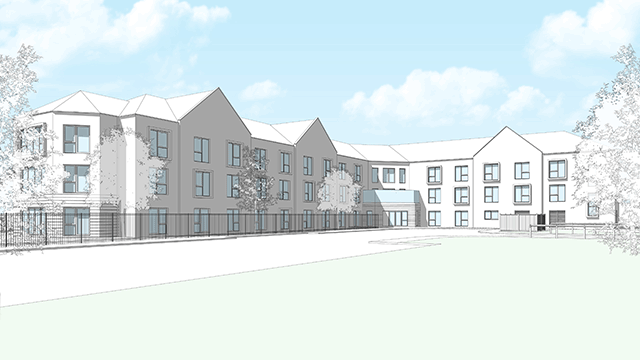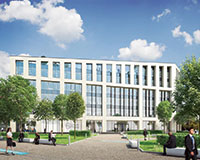Leeds is a market with writer’s block. After storming through 2013 with its best letting activity for 15 years, the city is now metaphorically staring blankly out of the window, despondently sucking on its Biro.
In 2013, Leeds city council expanded at Merrion House, the Yorkshire Building Society took space at Broad Gate and the Dart Group prelet the Mint. In 2014, the big movers are still torn between staying put and taking the leap.
Most of the headline transactions were signed at or around £25 per sq ft, long considered the going rate for Leeds grade A, with any upturn for landlords coming in the form of sharper incentives. But as the market cools from an exceptional year – take-up declined by 40% in Q1 2014 compared to the same period in 2013 – uncertainty is growing as to where exactly the price point now stands, and just how the development market is going to cope with rising costs and uncertain viability prospects.
But cope it must. With a grade-A supply of just 250,000 sq ft, or 1.5% according to Carter Jonas, nearly 500,000 sq ft of known requirements are bobbing around on the market – most notably the NHS, Addleshaw Goddard, DAC Beachcroft, BSkyB and PwC. Beyond this, nearly 1m sq ft of lease events are coming up in the next four years.
Power is very rapidly shifting into the hands of developers – a trend that the city’s big property players are anxious to communicate to occupiers.
JLL national office director Jeff Pearey says: “The overall cost of raw materials and labour has gone up, and if anything else is going to be refurbished or spec developed then the headline rent quoted for that will have to be higher than £25 per sq ft or it won’t be profitable enough. We’re still one of the less expensive big-six markets, there’s headroom for that and if any regional market is going to see rental growth, the pressure is most acute in Leeds. But I don’t think any occupier wants to be the first to signal a new high in the rental market.”
On the investment side, too, the city is looking beyond its borders to get some idea of where exit yields stand.
GVA director Ben Hall says: “We have not seen a grade-A, brand-new modern building transaction in quite a long time. The market’s moved since then – the other regional centres give the impression that grade A is selling at less than 6%. That might allow a development appraisal to stack up at £25 per sq ft but you’d need a 20-year lease.”
So what does the Leeds market think its space is worth? Our agency poll estimates a range from the aforementioned £25 to £30 at the more optimistic end of the scale.
Consensus says a likely lease for a major city-centre scheme will require £26-£27 per sq ft, with a rent-free period some 30% shorter than a year ago.
CBRE office agency director Jonathan Shires says: “If rents don’t reach that mark it’s going to be quite difficult to create new high-quality developments on some of our sites.
“It’s also driving the occupiers more and more that in order to attract and retain the right staff and the right corporate image, as well as their sustainability responsibilities, they need the best-quality building.”
Stick or twist
Smaller requirements can and will be mopped up by a wave of refurbishments coming to market shortly, pushing rents on secondhand space north of the £20 per sq ft mark. But none of these have the kind of floorplates that could attract the headline occupiers. Instead, whether the major requirements decide to regear or to move will be the real game changer for a market still not ready for widespread speculative projects – even if the funds are itching to back a prelet from a big name.
The good news is that occupiers who already regeared once during the recession are now beginning to see their ageing buildings for what they are, and as the company coffers recover, are starting to yearn for something shiny to attract and retain bright young staff.
PwC is a prime example of an occupier spurning the safe option and looking increasingly likely to make a bold prelet play.
But others are keeping the agency world eagerly waiting, and every week of delay from a major occupier is a week where a new requirement could come on stream, with all the implications that will have for rents and availability.
Meanwhile, the agency world is already having its head turned by the class of 2018, with a spate of lease events scheduled for that year.
As Savills head of Leeds office & director office agency Paul Fairhurst says: “The market needs a couple of the prelet occupiers who have been in the market forever to make some decisions.
“I think they’re all racing towards the finish line, doing the calculations, and one of them will blink pretty shortly.” But whether two will is another question. Getting occupiers to commit to a prelet in Leeds is no mean feat.
This is the conundrum facing many signature sites, such as Bruntwood’s Sovereign Square (top of page) where planning was submitted for 93,000 sq ft last month and MEPC’s Wellington Place which could accommodate a further 970,000 sq ft.
The large scale of these schemes relative to the city’s requirements is a drawback. Few developers will be willing to build anything without a 30-60% prelet, even with a modest uplift in rents, and not many requirements on the market can deliver this, particularly where projects cannot be phased.
High-rise spec: a tall order
So the age-old question arises once more: who, if anyone, is willing and able to spec in Leeds? Though Bruntwood and MEPC make bullish noises about their spec plans for Sovereign Square and Wellington Place, respectively, in truth Bruntwood is hoping against hope Addleshaw Goddard can be lured into its scheme, while MEPC has yet to make a hard commitment to spec.
Meanwhile, Roydhouse and Marrico’s 225,000 sq ft Central Square (right) has committed to a speculative start on site by June, with two potential pre-lets on the cards.
Central Square could become the city’s new poster child if a prelet with PwC is signed, with funds and banks lining up to fund the project. This would speak volumes about the new confidence permeating the market, with a PwC deal leaving 160,000 sq ft speculative at Central Square.
All this spells a period of uncertainty for the Leeds office market, but also one of cautious optimism. Leeds could continue to be the UK’s most dynamic regional office market in 2014, but this will require a strong cocktail of occupier audacity, developer daring and agency manoeuvrability.











